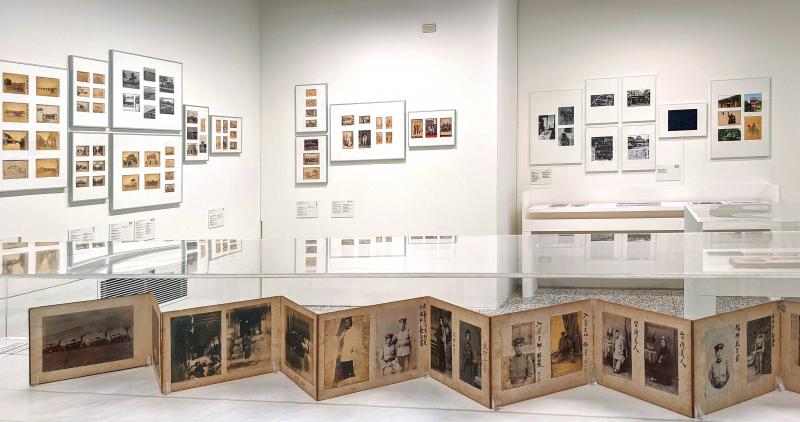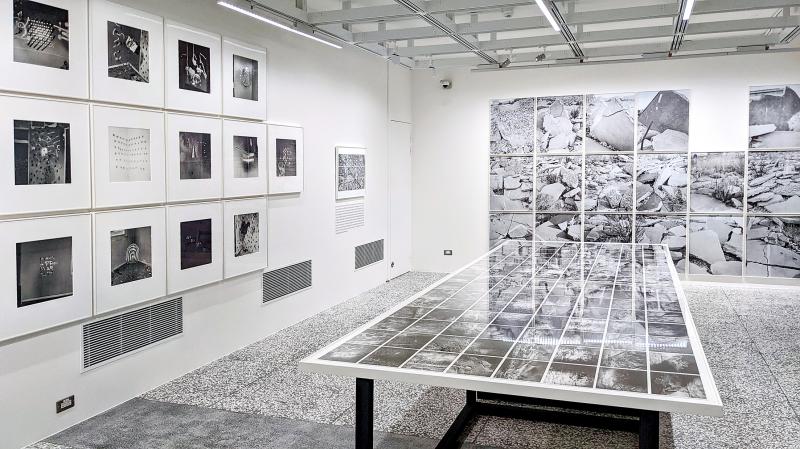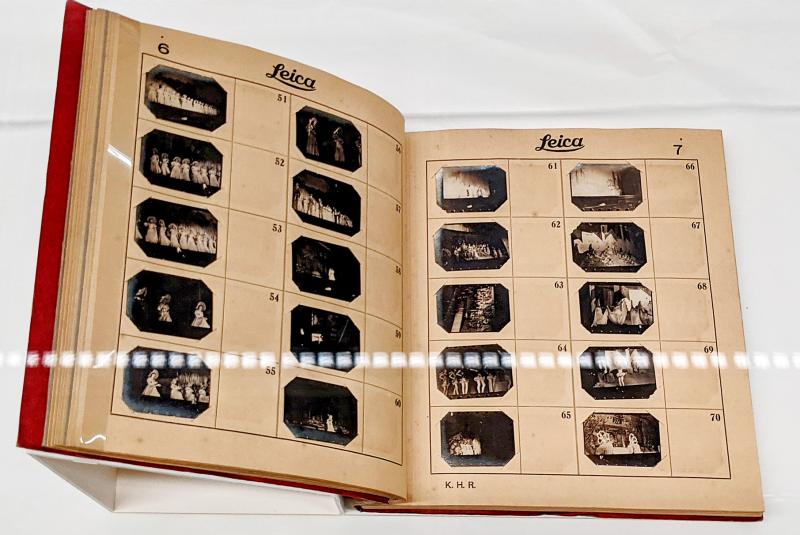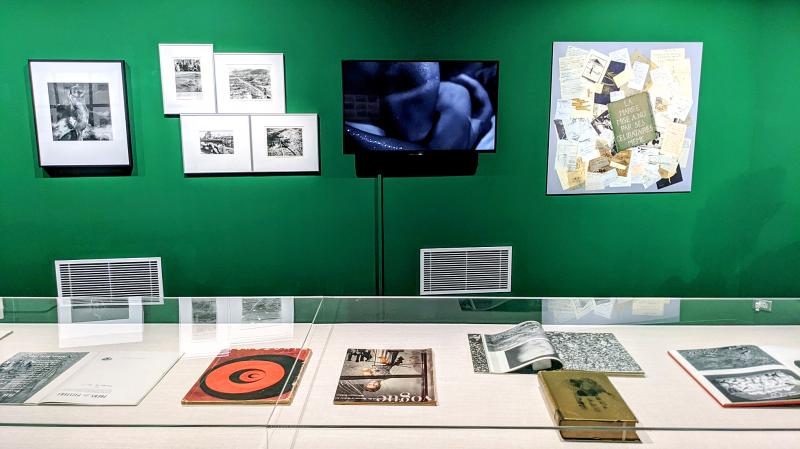Drawing from its collection of over 11,000 works, the National Center for Photography and Images’ (國家攝影文化中心) inaugural domestic exhibit, Hold the Mirror up to His Gaze (舉起鏡子迎上他的凝視), presents a valuable record of Taiwan’s photographic history from 1869 to 1949. It includes personal albums as well as pieces scanned from negatives acquired from now-shuttered photo studios. The subject matter shifts from the lens of visiting Europeans to Japanese colonizers to Taiwanese pioneers like Deng Nan-guang (鄧南光) and Chang Tsai (張才).
Such an overview is fitting for the center’s grand debut, but organizers are eager to point out that their collection is more than just about documentation.
Set within the same exhibition space is an accompanying exhibition curated by David Campany, who serves as the managing director of programs at the International Center of Photography in New York. A Handful of Dust: From the Cosmic to the Domestic is a conceptual show exploring various allegories represented by dust at various scales through the visual arts. The two radically different displays create a sharp contrast that somehow works.

Photo: Han Cheung, Taipei Times
The exhibitions are housed in a tastefully refurbished 84-year-old Japanese colonial-era office building that combines Asian and European architectural elements.
Preview tours are all booked up, but it will open to the public at no cost on April 20.
Fu Yuan-cheng (傅遠政), who heads the center, says after working closely with experts to establish the scope of the rescue efforts for Hold the Mirror up to His Gaze, they began collecting works that were scattered across Taiwan and the world. Nine experts participated in the research for the domestic show, including Magnum photographer Chang Chien-chi (張乾琦), whose work is also on display.

Photo: Han Cheung, Taipei Times
Many of the original prints have been lost to time and were stored in collections as film negatives or glass plates, which the museum was able to scan and reprint. While Deng left behind a limited number of works after he died in 1971, his family had carefully preserved his film for over 40 years. The value of these go beyond reproduction, Fu says.
“Through his film rolls, we can get a glimpse of how [Deng] framed his shots, or how he made his selections,” he says.
A few of these film albums are on view, organized chronologically and easily navigable with thought-provoking text to place the pieces in historical context.

Photo: Han Cheung, Taipei Times
The only complaint is that the description labels are placed too low, making the viewer have to bend down to read the text — and there are a lot of captions to read.
Labeling is also an issue with A Handful of Dust as all of the entries are grouped into one panel in the room, making the viewer have to run back and forth to match the piece to the text.
Inspired by Dust Breeding, a photograph by surrealist visual artist Man Ray showing dust gathering on a work by Marcel Duchamp, Campany’s selections run the gamut from the light-hearted and artistic to social issues and mass destruction. Who knew dust could generate such discussion and imagination?

Photo: Han Cheung, Taipei Times
The building housing the exhibition has been altered significantly over its life, and it’s evident that a great deal of work was put into restoring it. The full story of the building’s history and restoration can be found in the single-room permanent display, Trans-Communication (跨交通).
The first floor features a coffee and pastry shop with a market-style gift store, but the real gem is the cozy photography library hidden in the back where one can just kick back and pore through the work of the greats.
All in all, it’s an excellent show that hopefully provides inspiration in putting together future domestic exhibitions.

Photo: Han Cheung, Taipei Times

Photo: Han Cheung, Taipei Times

Photo: Han Cheung, Taipei Times

In the March 9 edition of the Taipei Times a piece by Ninon Godefroy ran with the headine “The quiet, gentle rhythm of Taiwan.” It started with the line “Taiwan is a small, humble place. There is no Eiffel Tower, no pyramids — no singular attraction that draws the world’s attention.” I laughed out loud at that. This was out of no disrespect for the author or the piece, which made some interesting analogies and good points about how both Din Tai Fung’s and Taiwan Semiconductor Manufacturing Co’s (TSMC, 台積電) meticulous attention to detail and quality are not quite up to

April 21 to April 27 Hsieh Er’s (謝娥) political fortunes were rising fast after she got out of jail and joined the Chinese Nationalist Party (KMT) in December 1945. Not only did she hold key positions in various committees, she was elected the only woman on the Taipei City Council and headed to Nanjing in 1946 as the sole Taiwanese female representative to the National Constituent Assembly. With the support of first lady Soong May-ling (宋美齡), she started the Taipei Women’s Association and Taiwan Provincial Women’s Association, where she

Chinese Nationalist Party (KMT) Chairman Eric Chu (朱立倫) hatched a bold plan to charge forward and seize the initiative when he held a protest in front of the Taipei City Prosecutors’ Office. Though risky, because illegal, its success would help tackle at least six problems facing both himself and the KMT. What he did not see coming was Taipei Mayor Chiang Wan-an (將萬安) tripping him up out of the gate. In spite of Chu being the most consequential and successful KMT chairman since the early 2010s — arguably saving the party from financial ruin and restoring its electoral viability —

It is one of the more remarkable facts of Taiwan history that it was never occupied or claimed by any of the numerous kingdoms of southern China — Han or otherwise — that lay just across the water from it. None of their brilliant ministers ever discovered that Taiwan was a “core interest” of the state whose annexation was “inevitable.” As Paul Kua notes in an excellent monograph laying out how the Portuguese gave Taiwan the name “Formosa,” the first Europeans to express an interest in occupying Taiwan were the Spanish. Tonio Andrade in his seminal work, How Taiwan Became Chinese,